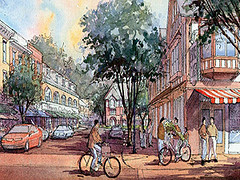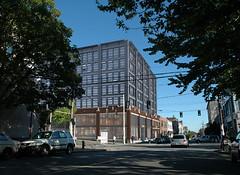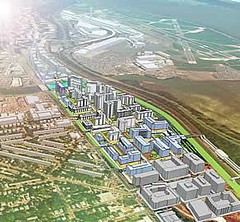The value and practice of smart growth endorsement

Posted February 22, 2011 at 1:33PM
We’ve had some interesting recent conversations at NRDC, still unresolved, about whether and when to support smart growth development. Some of my colleagues are understandably concerned that our support, particularly if qualified or based on assumptions that fail to be realized during the course of further design and construction, could be abused by developers. Others of us are concerned that, if we do not support things – including land development - that are good for the environment, we will lose credibility when all we do is criticize.  And, besides, getting more smart growth on the ground obviates increments of sprawl, reduces pollution and is very good for the more sustainable future we all seek.
And, besides, getting more smart growth on the ground obviates increments of sprawl, reduces pollution and is very good for the more sustainable future we all seek.
This is a large part of the reason that NRDC helped create LEED for Neighborhood Development, which has been designed explicitly to provide support for good development, as defined by its environmental criteria. But, while we had a big role in creating the system, NRDC has little to do with administering it. So a favorable LEED-ND rating does not equate to an organizational endorsement.
In fact, we may well not support all projects that obtain a certification under the system, because it does not fully capture all of our values. (Not much weight in LEED-ND scoring is given to green space, historic preservation, or affordable housing, for example; there are also loopholes in the location criteria.) But the system is not a bad surrogate for many of the basics of smart growth, and it should provide a helpful green stamp of approval for many good proposals, especially those that earn a high rating, such as platinum or gold certification.
Another way of providing that stamp of approval may be found in locally created and administered development endorsement programs, some of which predate LEED-ND. One of the best and most longstanding of these, for example, is administered by the Greenbelt Alliance in the San Francisco Bay Area.  Another, which combines both industry and environmental participation in equal measures is that of the Washington (DC) Smart Growth Alliance, created by several local associations and organizations with the assistance of the Urban Land Institute. The Washington Alliance evaluates projects not against uniform technical measurement as does LEED-ND, but against a set of criteria as applied on a case-by-case basis by a jury selected by the Alliance. (The Greenbelt Alliance has a similar “compact development evaluation team” of volunteers assisted by Alliance staff.)
Another, which combines both industry and environmental participation in equal measures is that of the Washington (DC) Smart Growth Alliance, created by several local associations and organizations with the assistance of the Urban Land Institute. The Washington Alliance evaluates projects not against uniform technical measurement as does LEED-ND, but against a set of criteria as applied on a case-by-case basis by a jury selected by the Alliance. (The Greenbelt Alliance has a similar “compact development evaluation team” of volunteers assisted by Alliance staff.)
Programs similar to the DC area’s have been created for the Delaware Valley that includes the Philadelphia and Wilmington metro areas, and for the Seattle-Tacoma metro area. Along with the DC program, the Delaware Valley and Seattle programs are profiled in a highly informative article written by Philip Langdon and posted on the New Urban Network. ULI played an important role in creating all three of these.
A key aspect of these programs is that the sponsors agree to testify in public hearings in support of endorsed projects. As one can imagine, smart growth developers find this enormously helpful, especially in strengthening the resolve of local government entities who are unsure whether projects are really worthy or not.
 Langdon reports that, because of the national real estate slump, business has dropped off somewhat for these programs but is now picking up. The DC area program has endorsed 61 projects since its creation nearly a decade ago; most have been built or have begun construction since endorsement, and most of the rest are on track to construction.
Langdon reports that, because of the national real estate slump, business has dropped off somewhat for these programs but is now picking up. The DC area program has endorsed 61 projects since its creation nearly a decade ago; most have been built or have begun construction since endorsement, and most of the rest are on track to construction.
The programs are not perfect, though, writes Langdon. The first two projects pictured with this post – the Franklin Mint redevelopment in Philadelphia, and the Sunset Electric building adaptation and expansion in Seattle – meet his approval from a new urbanist perspective, as does the third, a master plan for the former Potomac Yards site in Alexandria, Virginia. But the fourth, part of the massive Tysons Corner makeover near the Capital Beltway and the DC Metro’s Silver Line, under construction, does not enjoy his confidence:
“The [rendering’s] view from the air shows tall buildings suggestive, in the words of Ian Lockwood, a transportation engineer at AECOM in Orlando, Florida, of ‘different perfume bottles all lined up on a shelf’ — the usual approach of nontraditional architects who lack experience in creating urban ensembles. Will people find a lively experience in the public spaces at ground level? It’s hard to tell. The fact that most of the illustrations on the project’s website (click here) are aerial views leads
an urbanist to suspect that the designers focused only a fraction of their attention on the experience of the pedestrian.”
Langdon suggests that the endorsement of the Tysons project by the Washington Smart Growth Alliance exposes a difference between smart growth (primarily concerned with environmental performance) and new urbanism (primarily concerned with design for placemaking). He may be right about that. But I have to say that this smart growth advocate doesn’t much like the Tysons design, either. Among other things, it looks overscaled to me.
Langdon quotes my friend and frequent speaking partner David Dixon, principal at Boston’s Goody Clancy architects, as finding most of the endorsed DC-area projects “pretty good,” but also that “many people in the smart growth movement have not fully embraced or understood what it takes to create the quality and character of environment that is necessary. How do you get the density right?” As I have written here often, I mostly agree, though I think we’ll get better over time.
Langdon’s article also references ULI’s “Reality Check” series of regional visioning workshops, which I really like. Typically, the organization and local partners assemble a large group of regional stakeholders, give them the best available data on growth forecasts along with existing and projected conditions on the ground, and let them determine how best to accommodate the predicted amount of growth. I think Reality Check is not only a great wake-up call for stakeholders who may be blind to what’s going to happen but also a terrific hands-on lesson in what regional planning is all about. I previously wrote about Reality Check here, and ULI has a report about the program and the ULI-assisted endorsement programs here.
I have just scratched the surface of Langdon’s article, which I highly recommend for readers interested in learning more about these programs.
Move your cursor over the images for credit information.